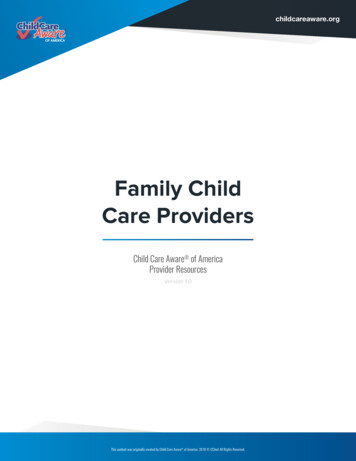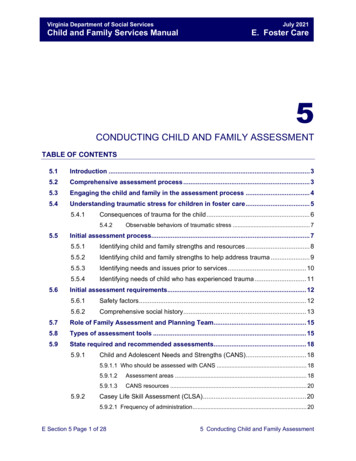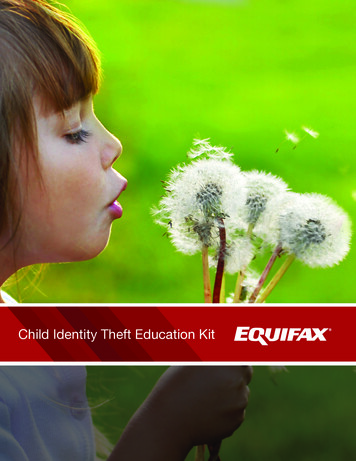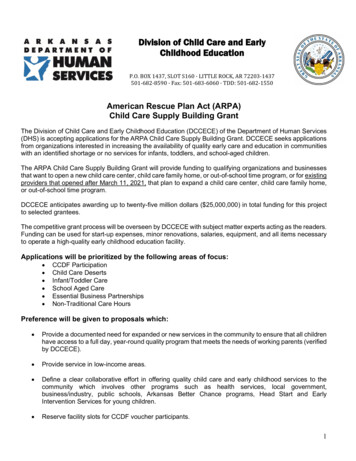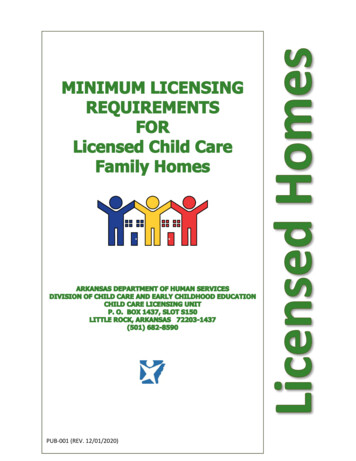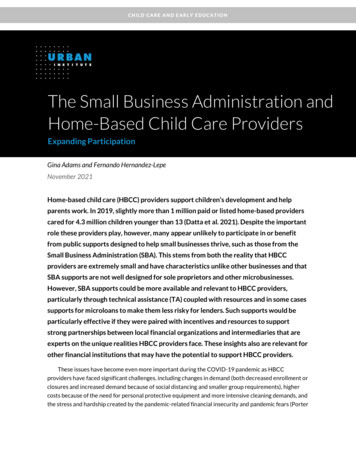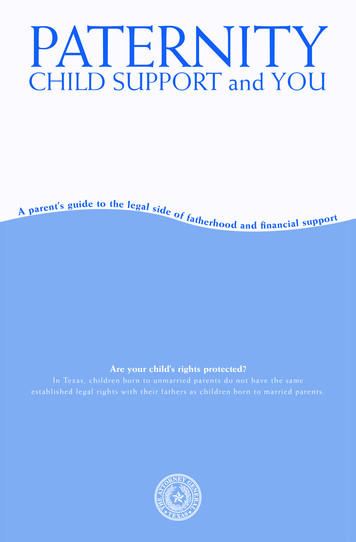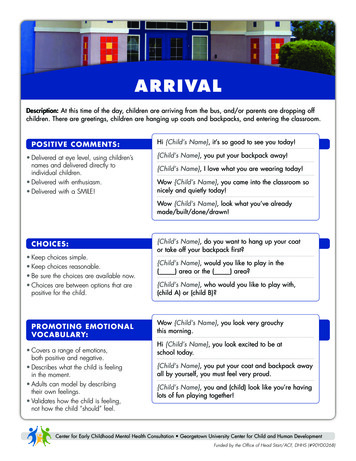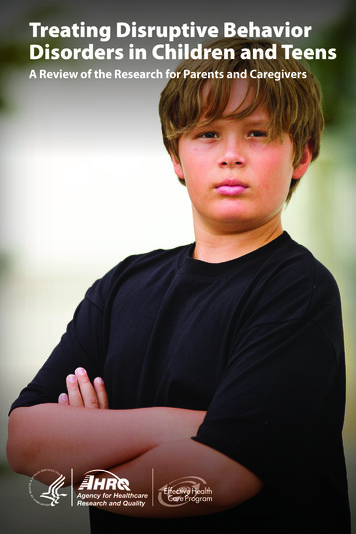
Transcription
Understanding Child & FamilyTeam (CFT) MeetingsPCWTA is a program of the Academy for Professional Excellence at San DiegoState University School of Social Work in collaboration with our Universitypartners, CSU San Bernardino, Loma Linda University and CSU Fullerton10/23/14
Agenda Overview General Timeframes: Morning/Midday/Afternoon/Adjournment– Toys, books, CFS “Alphabet Soup” “Trainers” impart new info, reinforce prior learning,ACT as Facilitator, be transparent, refer to Coaches Coaches Ongoing application/transfer of learning &support for facilitating CFTMs Day One: Overview of Child & Family Team Meetings& demonstration/practice of a meeting2
Learning Objectives Understand the 3 dimensions of facilitated practice Increase skills on building shared understanding and sharedagreements Understand basic facilitation skills Understand respectful engagement of participants in CFTMs Facilitate exploration of worries, what’s working well and whatneeds to happen Facilitate exploration of safety networks and collaboratively planwith families3
Group Agreements How will we work together? What tools or strategies are helpful for effectivedialogue? “The Four Agreements”––––Don’t take anything personallyDon’t assumeDo your bestBe impeccable4
Gradients of Agreement (Scale)VetoNo way,No How!EndorsementNotcomfortable,but won’tstand in wayof plan.Could goeither way.I like it.I love it!5
OVERVIEW OF KATIE A COREPRACTICE MODEL6
Who is Katie A? Katie A was a 14 year old girl at the time the lawsuitwas filed She was placed in foster care at the age of 4 She moved through 37 different placements in the10 years she spent in foster care Early assessments indicated services were needed,but she did not receive trauma treatment orindividualized mental health services7
The Lawsuit July 2002: Katie A. et al v. Diana Bonta et al. filed againstCDSS, DHCS and the County of Los Angeles Lawsuit filed by young adults who had aged out of fostercare in LA county on behalf of a class of children inCalifornia Seeking improved access to Wraparound services andTherapeutic Foster Care for children in or at risk ofplacement in foster care or group homes Dec-2011: Settlement agreement reached, subclassmembers identified, and the State is asked to takespecific actions8
Class and Subclass Class members include: children in foster care,children at risk of placement in foster care, childrenwith a mental health condition, children in need ofindividualized mental health services, and children inan open CWS case (in this county “all our kids on our caseloads, 0-21”w/a few exceptions, e.g.- not safely-surrendered) Subclass includes: children with an open CWS casewho are full scope Medi-Cal eligible and have anopen CWS case AND meet the medical necessitycriteria for Specialty Mental Health Services9
CFS and DBH Collaboration Co-location of DBH Clinicians in CFS OfficesMental Health Screenings and AssessmentsIdentification of Katie A Subclass MembersSARTHealth HomesWraparoundSuccess FirstOther DBH Contracted Services/ProvidersNeed Assistance? Call (909) 387-7000
Mental Health Screening ToolsUniversal Referral Form (URF) 234URF 235URF 235If Child Not Currently Receiving Mental HealthServices THEN Screening Is: Conducted Initially Every Six (6) Months or at Case Plan Update Documented in Health and Educational Passport(HEP)
The State of California Response:The Core Practice Model (CPM) The Core Practice Model (CPM) articulates a familycentered approach that is intended to improvecoordination and collaboration among mental health,child welfare and children and families involved withthe child welfare system who have mental healthneeds12
Core Practice Model (CPM) Elements Teaming with families for collaborative planning Trauma-informed practice– What’s happened vs What’s wrong CPM components, standards & activities include:– Engagement– Assessment– Service Planning & Implementation– Monitoring & Adapting– Transition For Subclass Members:– ICC, IHBS, Therapeutic Foster Care13
California Core Practice Model (CPM) Initiatives Working Together To Improve Outcomes for Childrenand Families Shared Responsibility Collaboration Cultural Competence/Humility Child Centered/Family Focused/Driven System Permanency Evidenced Based Practice Transparency Disproportionality/Disparity Accountability
CPM Values and Principles Children and protected from abuse/neglect and maintainedsafely in their homes Services are: Needs driven, strengths based, family focused Individualized/tailored to the strengths/needs of thechild/family Multi agency approach/community based Formal/informal resources Culturally competent Child(ren) to have permanency/stability in living situations Parent/child voice assured throughout the process
CPM: Teaming With Families Collaboration Diverse Team Membership Guided by the Family’s input, theirneeds and preferences All Members Participate in theDevelopment and Implementation ofthe Plan
CFT Meeting Defined Team meetings are the vehicle through which ongoingassessment of needs, case planning, and intervention,monitoring and adapting are facilitated Decisions should be made within the context of the team A CFTM should occur regularly and consider: Risk Assessment/Safety Planning– Team Membership (who else should be on the team?)– Team member roles/responsibilities in between meetings– The effectiveness of the plan in meeting the needs and goals ofthe family17
CFT Best Practice Child and Family Teams must be delivered for everychild/youth identified as a subclass and class member CFT must include at least:– CFS Social Worker– Mental Health Clinician (if child is receiving mental heathtreatment)– Child– Other Family Members– Others CFT continues throughout the life of the case and endswhen the case closes18
CFT Meeting Guidelines For Subclass: must have the initial CFT meeting within 30 days of themembership designation date subsequent CFT meetings must occur every 90 days or asneeded to meet the child and family’s needs or until thechild/youth no longer has subclass membershipdesignation For Class: have initial CFT meeting as soon as possible subsequent CFT meetings must occur every 90 days or asneeded to meet the child and family’s needs19
Social Worker Role in a CFT MeetingsFor Class Members Social Worker to coordinate/assist withcoordination of CFT meetings Social Worker to facilitate CFT meetings Social Worker can wear “multiple hats” during CFTmeetingsFor Sub-Class Members Participate in CFT Meetings DBH partners responsible for facilitating CFT meetings Social Worker could be the facilitator/co-facilitator of CFTmeetings20
Social Worker Duties in a CFT Meetings forClass Members Maintain risk assessment/ safety planning as the priority CFS SW is the “subject matter expert” in risk assessment, safetyplanning and all CFS matters Ensure everyone on the team has a voice Explore/Identify: the needs of the family, their goals, their planand potential challenges of them reaching their goal Coordinate/schedule follow up CFT meetings Complete all the necessary paperwork Ensure team members get copies of Individual Care and Safety Plan Advocacy Documentation Others?21
Social Worker Duties in CFT Meetings forSubclass Members CFS SW is the “subject matter expert” in riskassessment , safety planning and all CFS matters Attend CFT meetings Be part of the team Obtain necessary paperwork Document Others?22
OVERVIEW OF CHILD AND FAMILYTEAMS23
Who Needs to Be Involved
Appropriate Types of Discussions in aCFT MeetingSafety(Harm & DangerStatements, SafetyGoals)NOT: Why did you run away?NOT: What are you doing wrong?How can I do a better job for this child and family?WellbeingPermanency(mandated in theSettlement)(Stay Home, ReturnHome, Find a Home)
TDM vs CFTTDM About a placement changeCFT About the family &child/youth needs & goals Seeks consensus regarding aplacement decision Addresses the risks, needs& strengths of the family &child/youth26
How Are They Related?CPMCFT/CFTMs/TDMs/TCsSOPCAT
Three Dimensions to Attend ToCONTENTPROCESSRELATIONSHIPS
STRUCTURE OF CHILD AND FAMILYTEAM MEETINGS29
Structure of a Child and Family Team Meeting Pre-Meeting and then:
Our Process to Reviewthe Pre-Meeting & Super 8 Discuss, demonstrate Discuss, demonstrate, practice Discuss, demonstrate . FOCUS: Peters/Jackson Family31
Peters/Jackson FamilyStakeholders1. Monica Peters – Mom, 28 , Caucasian2. Jimmy Jackson – Step-Dad, 30, African-American3. Doris Jackson – Jimmy’s Mom, 53, African American4. Ronnie Wilcox – School Counselor/Case Mgr, 37,Caucasian5. Joshua – Child, 8, Caucasian6. CFS worker
Prior to the MeetingPrepare Individualsfor the Meeting
In Advance of the Meeting Actively screen for and identify in advance anyknown propensity for violence Explore with each family participant if there are anycourt orders that prohibit contact with anyone Who are “Offenders”– verbally, physically with eachother/child Options for participation .– Phone?– Separate meeting for each care provider?34
DEMO: PRE-MEETINGS with MonicaPrepare the Family for the Meeting Purpose of the meeting How long it will last What will happen if they choose not to participate Prepare the family to tell their story Explore what the goal of the initial CFTM will be Group Agreements Who to invite Safety check-in35
Safety Check-in: After the Meeting If there are ANY concerns about the impact of themeeting on safety, the worker should check inprivately with family members about any violence orthreats that occurred after the meeting36
Family Safety Circles37
Dyads Try it out Role 1 CFS Worker Role 2 “Monica”Worker, help Monica to identify members of her familysafety circle which might help to inform who might beasked to be part of the CFT . And possibly the CFTM!38
Introductions/Welcome Allow family to introduce themselves first and to telltheir story Others in the room should introduce themselves andtell how they are connected to the child/family Agency/Professional staff should introducethemselves last and explain what their roles are tothe CFT One suggestion would be to have staff standing upand talking to each other as family enters the room,and then continue39
DEMOFirst Stages & Key Questions Introductions/Welcome: Who is in the room & howare you connected to the child? Review Purpose and Desired Outcomes of Meeting*:Why are we meeting? What do we want to walkaway with? *Already id’d in pre-meeting with some stakeholders40
Ensure There Is Agreement About What will the group be doing together? What do people want to walk away with? Overall, why are we meeting today?41
During the Meeting Introduce the Safety Agreement: “This meeting is a place ofphysical and emotional safety for all who participate.Examples of how we ensure safety are that we respect courtorders prohibiting contact between people, we givepermission for each person to keep themselves safe during themeeting, and I might suggest a time-out or a break, or thatwe move into separate meetings. We adhere to “Nothingabout us without us” except when there is a safety concern fora participant.” Facilitators & participants pay attention for any behavioralindictors that someone in the meeting is feeling unsafe, andrespond accordingly– Agreed-upon “signals” for fear/anxiety/triggers– “Seating arrangement” ideas?42
DEMO: Context Provide Context of Meeting: Is there anything that might distract ourfocus?43
Set the stage for effective dialogue What is happening outside the room that pulls attentionaway from what we are doing together? What power dynamics/imbalances are present that needto be made explicit? Be sure to “call out” the power ofthe worker in writing a report, etc– Despite this power imbalance, the goal is to include the family’sperspective to get to overall better outcomes, using familyconnections, etc Is there anything that might pull our attention away fromour focus today? What are the cultural/diversity issues that may bepresent in the meeting? If family already had TDM point out differences w/CFT.44
Discuss & Practice: Group Agreements HOW do we want to work with each other?45
Establish Working Agreements This is an agent of change– especially for first time! Great process for observation & “data collection” about thisfamily Explore how the group will work together in this meeting andafter this meeting Explore what agreements are needed for effective dialogue Push group to come up with positive reframes that state whatto do, as opposed to what not to do The last agreement should always be that the group takesshared responsibility to hold each other accountable for theagreements Be prepared with suggested agreements46
Group AgreementsAction: at your tables Roles id’d––––––CFS FacilitatorMonicaJimmyDorisJoshuaRonnie Create a list of group agreements– “Flesh out” as necessary– Don’t assume everyone defines term the same!47
DEMO: Review Network/Stakeholders Is everyone here . That NEEDS to be here? If not,what should we do to get them here?48
Networks/Stakeholders Assess if everyone is here who needs to be here– If not, what should we do to get them here Explore with the CFTM if the family was given theopportunity to invite support people The family should be provided the opportunity tospeak first and last if they choose to do so49
DEMO: Individualized Care Plan/Safety Plan What do we we want to talk about? (Consider actualsafety mapping, safety circles, case consultation, etc) What’s working well? What are our worries? What ideas do we have for next steps?50
Helpful Types of Questions to Ask Three QuestionsSolution Focused QuestionsOpen ended questionsWho, what when, where, and how questionsCoping questionsRelationship questionsException seeking questionsScaling questionsMiracle/Hoped for future question51
ACTION: Individualized Care Plan/Safety Plan Roles Id’d––––––CFS FacilitatorMonicaJimmyDorisJoshuaRonnie What’s working well? What are our worries? What ideas do we have for next steps?52
DEMO: Review Next Steps What steps do we need to take from here? Who doeswhat? By when? Next meeting date?53
Next Meeting Next prioritized steps/actions to “try on” Anyone else need to be invited to next meeting?– Foster families Schedule the next meeting54
LAST STEP . Of the CFTMPLUS/DELTA(We’ll pause that right now . To return soon .)55
Plus/Delta Feedback Draw two columns on flip chart paper Plus Strengths of the Meeting Delta (Greek symbol for change) upgrades that arenot necessarily negative it’s just somethingparticipants suggest to change All responses are TRUE Facilitator/Scribe needs torefrain from “arguing” or “correcting” or “defending”56
This presentation is brought to you by:Public Child Welfare Training AcademyPCWTA is a program of the Academy for Professional Excellence at San DiegoState University School of Social Work in collaboration with our Universitypartners, CSU San Bernardino, Loma Linda University and CSU Fullerton57
PCWTA is a program of the Academy for Professional Excellence at San Diego State University School of Social Work in collaboration with our University partners, CSU San Bernardino, Loma Linda University and CSU Fullerton Understanding Child & Family Team (CFT) Meetings 10/23/14
